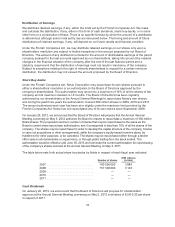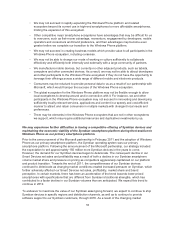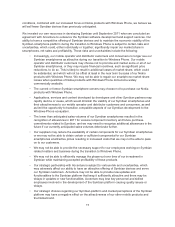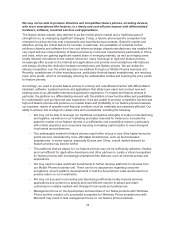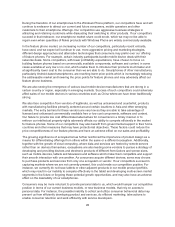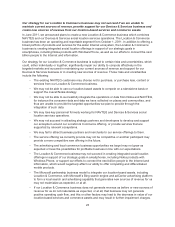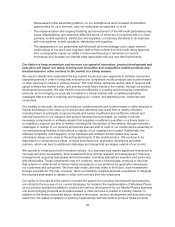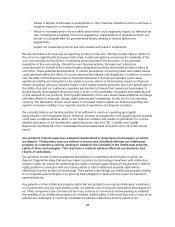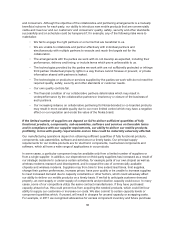Nokia 2011 Annual Report Download - page 22
Download and view the complete annual report
Please find page 22 of the 2011 Nokia annual report below. You can navigate through the pages in the report by either clicking on the pages listed below, or by using the keyword search tool below to find specific information within the annual report.During the transition of our smartphones to the Windows Phone platform, our competitors have and will
continue to endeavor to attract our current and future consumers, mobile operators and other
customers to their smartphone offerings. Our competitors use aggressive business strategies in
attracting and retaining customers while dissuading their switching to other products. If our competitors
succeed in that endeavor, our smartphone market share could erode, which we may not be able to
regain even when quantities of Nokia products with Windows Phone are widely commercially available.
In the feature phone market, an increasing number of our competitors, particularly recent entrants,
have used, and we expect will continue to use, more aggressive pricing and marketing strategies,
different design approaches and alternative technologies that consumers may prefer over our offering
of feature phones. For example, certain industry participants bundle mobile device deals with their
networks deals. Some competitors, with lower profitability expectations, have chosen to focus on
building feature phones based on commercially available components, software and content, in some
cases available at very low or no cost, which enable them to introduce their products much faster and
at significantly lower cost to the consumer than we are able to do. Smartphones of other manufactures,
particularly Android-based smartphones, are reaching lower price points which is increasingly reducing
the addressable market and lowering the price points for feature phones and may adversely affect our
feature phone business.
We are also seeing the emergence of various local mobile device manufacturers that are strong in a
certain country or region, especially in emerging markets. Success of such competitors could adversely
affect sales of our mobile devices in various countries such as China where we have been traditionally
strong.
We also face competition from vendors of legitimate, as well as unlicensed and counterfeit, products
with manufacturing facilities primarily centered around certain locations in Asia and other emerging
markets. The entry barriers for these vendors are very low as they are able to take advantage of
licensed and unlicensed commercially available free or low cost components, software and content.
Our failure to provide low cost differentiated alternatives for consumers in a timely manner or to
enforce our intellectual property rights adversely affects our ability to compete efficiently in the market
for feature phones. Some of our competitors may also benefit from governmental support in their home
countries and other measures that may have protectionist objectives. These factors could reduce the
price competitiveness of our feature phones and have an adverse effect on our sales and profitability.
The growing significance of ecosystems has further reinforced the importance of product design as a
means for differentiating offerings from others within the same or a different ecosystem. Additionally,
together with the growth of cloud computing, where data and services are hosted by remote servers
rather than on devices themselves, ecosystems are also leading some vendors to pursue a strategy of
developing and providing devices and electronic products of different form factors and screen sizes,
such as mobile devices, tablets and televisions and software which make them compatible and support
their smooth interaction with one another. As consumers acquire different devices, some may choose
to purchase products and services from only one ecosystem or vendor. If our competitors succeed in
capturing markets where we are not currently present, this could erode our competitive position. For
instance, we currently do not have tablets or other adjacent products in our mobile product portfolio,
which may result in our inability to compete effectively in the tablet and developing multi-screen market
segments in the future or forgoing those potential growth opportunities, and may also have an adverse
effect on the desirability of our smartphones.
Consumers may be more reluctant to provide personal data to us, which would hamper our competitive
position in terms of our current business models, or new business models, that rely on access to
personal data. For instance, the possible inability to collect and utilize consumer behavioral data may
prevent us from efficiently developing product and services, do efficient marketing, take actions to
enable consumer retention and work efficiently with service developers.
20


